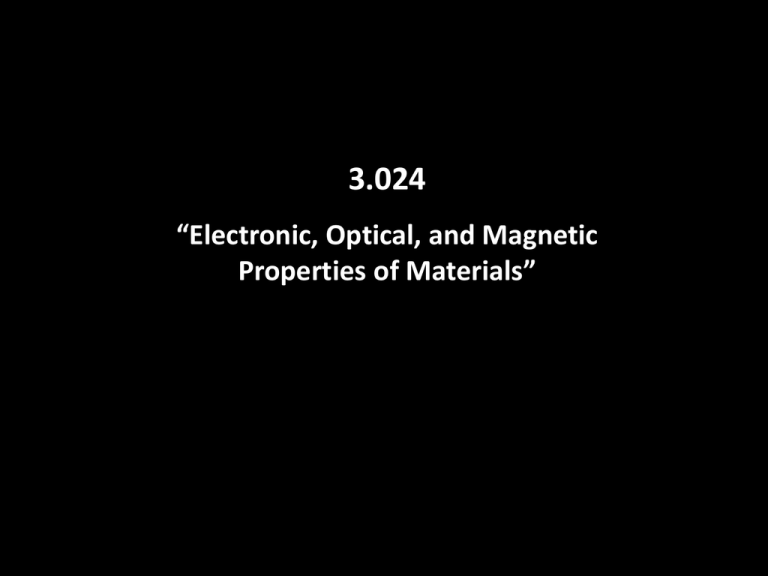
3.024
“Electronic, Optical, and Magnetic
Properties of Materials”
1
3.024
Objectives and Approach
• How can we understand and predict electrical, optical and magnetic properties?
Emphasis on fundamental physical models in lectures
• Application to real life situations?
Emphasis on real life examples in HW and recitations
• How do we measure EOM properties?
Emphasis on property measurements in labs using modern state-of-the-art tools
• Can materials properties be engineered?
Property engineering labs
2
3.024 Topics
•
Hamiltonian mechanics with application to normal vibrations in crystals
Phonons: dispersion relations, normal modes.
•
Introduction to Quantum Mechanics: Schrodinger’s Equation.
Applications to quantum dots, tunneling devices
•
Localized vs. delocalized states: from the free electron to the atom
•
Electronic states in crystals: DOS, bandgaps, interpretation of band diagrams.
•
Fermions, symmetrization and Pauli’s exclusion principle:
Electrons in bands and the classification of solids.
•
“Free electron” description of metals: response to EM fields
•
The chemical potential: Fermi energy, statistics of electron distribution
•
Electronic structure of semiconductors: intrinsic and extrinsic
•
Electronic devices
•
Optical properties of semiconductors, insulators and metals
•
Opto-electronic and optical devices
•
Magnetic properties of materials
3
Materials Shaping the World
Steel
Aluminum
Polymers
Silicon
Silica
AlNiCo
What’s Next?
4
How Do Materials Properties Interact?
vs.
© sources unknown. All rights reserved. This content is excluded from our Creative
Commons license. For more information, see http://ocw.mit.edu/fairuse.
Low
Electrical Conductivity?
High
Low
Thermal Conductivity?
High
Real
Refractive Index?
Complex
5
Materials Under Voltage
I
V
R
Steel rods and silicon ingot prior to slicing © sources unknown. This content is excluded from
our Creative Commons license. For more information, see http://ocw.mit.edu/fairuse.
• What determines whether
material be a resistor or a diode?
I
V=IR
Linear,
Ohmic
V
• How would you predict it?
• How much voltage or current
can material handle?
• What happens if we shine light
onto a material?
6
I
Rectification,
Non-linear,
Non-Ohmic
dark
light
V
Materials in Modern Electronics
Silicon: Material that enabled the World as we know it
1947
Image removed due to copyright
restrictions. Three photos of
transistor gates circa 2000, 2001,
and 2012 in nanometers.
Si processing
Diode
Transistor
The first transistor, invented at Bell Labs, December 23,
1947. (This image is in the public domain)
1950s
Today
vs.
Three of the women programmers of the ENIAC computer. (This image is in
the public domain)
7
Photo courtesy of Craig Saila on Flickr.
Does Size Matter?
Photo courtesy of Kerrythis on Flickr.
Could materials properties be size dependent?
8
What Happens When Materials Become NANO?
Size dependent absorption and emission
of CdSe nanocrystals (quantum dots)
CdSe is a tetrahedral semiconductor with a
Wurtzite structure absorption edge at
1.741eV (@295K):
1. How does it become transparent?
2. Why does it emit light upon excitation?
3. Why does the wavelength of emission
depend on the size?
Courtesy of Bawendi Lab at MIT. Used with permission.
d
“Particle in a box”
Courtesy of Felice Frankel. Used with permission.
9
Engineering Materials Properties to Manipulate Light
Figures and graph removed due to copyright restrictions.
Periodic structures yield to “optical bandgap”:
• This implies that we can create waveguides
transporting various wavelengths of light
from UV to deep IR without loss.
• We can use these waveguides
in telecommunication and medicine.
10
Magnets Around Us
© R. Nave. All rights reserved. This content is excluded from our Creative Commons
license. For more information, see http://ocw.mit.edu/fairuse.
From Prof. Beach
Can energy dissipation be useful?
Neurons expressing heat
sensitive proteins
Magnetic nanoparticles
converting EM waves to heat
.
From Prof Beach
Anikeeva Lab @ DMSE
11
Use magnetic
nanoantennae to
stimulate neurons:
Non-invasive
treatments of
neuro-disorders
MIT OpenCourseWare
http://ocw.mit.edu
3.024 Electronic, Optical and Magnetic Properties of Materials
Spring 2013
For information about citing these materials or our Terms of Use, visit: http://ocw.mit.edu/terms.




